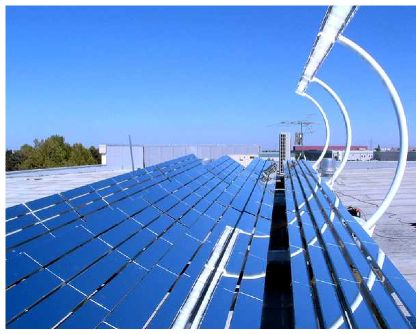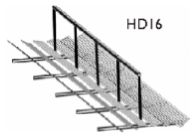Solar Concentrators: Difference between revisions
(→Power) |
(→Power) |
||
| Line 16: | Line 16: | ||
*The 200 kW obtainable per acre is still better, even on a per-acre basis, than coal power plants. | *The 200 kW obtainable per acre is still better, even on a per-acre basis, than coal power plants. | ||
**Coal power plant of 1 square mile - 640 acres/mile * 200kW/acre ~ 100 MW output per square mile if the area was in solar concentrators. So, 10 square miles would be a gigawatt power plant. This is comparable to the area and output of coal plants. | **Coal power plant of 1 square mile - 640 acres/mile * 200kW/acre ~ 100 MW output per square mile if the area was in solar concentrators. So, 10 square miles would be a gigawatt power plant. This is comparable to the area and output of coal plants. | ||
**Nuclear power plants are typically 1 square mile in size [http://www.nucleartourist.net/areas/areas.htm] | |||
*It is also twice the per-acre power of the most advanced Stirling engine thermal electric generators. [http://peswiki.com/index.php/Directory:Stirling_Energy_Systems] | *It is also twice the per-acre power of the most advanced Stirling engine thermal electric generators. [http://peswiki.com/index.php/Directory:Stirling_Energy_Systems] | ||
**This is not because the advanced Stirlings are not efficient, but because there is so few of them per acre. | **This is not because the advanced Stirlings are not efficient, but because there is so few of them per acre. | ||
Revision as of 04:40, 27 January 2008
Feasibility Study
We must go through a basic feasibility study to understand the importance and potential of solar concentrator power. First, we are considering solar concentrators for solar electric power. While there are many solar electric system options available, from photovoltaics and stirling engines to Rankine cycle low temperature electrical generators, we believe that the boundary layer turbine with solar concentrators is the lowest cost, most ecological, and simplest to manufacture.
Power
Consider these basic facts relevant to power:
- Solar insolation on a clear day is about 1 kW/square meter
- Considering cloud cover and day/night cycles, a place like Missouri gets 6 kWhr/square meter/day of insolation throughout the year, on average. [1]. You can check the insolation for your location in the uSA as well.
- The earth intercepts 10,000 more times energy from the sun than we currently use in all fossil and nonfossil fuels today.
- The energy intercepted per acre of land is 4 megawatts.
- If overall energy conversion efficiency for that land area were 5%, then you would produce 200kW of power from that acre of insolation.
- The boundary layer turbine is proven to be at least 25% efficient for unoptimized experiments in the literature. [2]
- Counting overall system efficiency, 10% efficiency is easily attained
- If only half the land area is solar collectors (rest is access, etc.), then 5% is a reasonable figure
- The 200 kW obtainable per acre is still better, even on a per-acre basis, than coal power plants.
- Coal power plant of 1 square mile - 640 acres/mile * 200kW/acre ~ 100 MW output per square mile if the area was in solar concentrators. So, 10 square miles would be a gigawatt power plant. This is comparable to the area and output of coal plants.
- Nuclear power plants are typically 1 square mile in size [3]
- It is also twice the per-acre power of the most advanced Stirling engine thermal electric generators. [4]
- This is not because the advanced Stirlings are not efficient, but because there is so few of them per acre.
We are proposing linear collectors of this type:
 from [5]
from [5]
Cost
And basic cost figures are:
- Cost of mirrors for such a collector is about $1/sq ft
- The heart of a solar collector is mirrors
- Balance of system costs for the collector incude structure and collector tube assembly
- Balance of system costs should be about $5/sq ft
- Costs for solar cells that are presently available are $40/sq ft, or a factor 8 more
- The boundary layer turbine [6] cost is negligible compared to the collector cost - $300 for the model that we are developing
- Collector costs for the 5 kW turbine generator are:
- 500 square feet => 50 sq meters => 50,000 W @10% efficiency => sufficient for 5 kW electric generation
- But, turbine scales at $20 per additional kilowatt of power output, and $40 for additional electric power output.
- Cost of 500 square feet is $2500.
- Nominal 5 kW system costs $3500, which is <80 cents/watt of installed power
- Nominal 100 kW system costs $25,000 for solar concentrators, and $2500 for generator heads, and about $2500 for the turbines.
- Total of $30k for 100 kW or about 30 cents per watt of installed power
Bottom line: this is cheaper than any known power generation strategy.
Reality Check
One must study the above data carefully to become convinced of the possibility. The greatest question that may arise is not whether the efficiency of the turbine is correct. The figure of 10% that we are using has been proven, and it is conservative. The real question is, can the cost deliverables be met.
Using the simplest possible structural design for the concentrators, described in our proposal in Fig. 5a, such as:
the $5/sq ft balance of system cost should be achievable. If it is not achievable by utilizing off-shelf steel or lumber components, then we will utilize compressed earth blocks [9] and self-milled lumber [10] to reach the cost requirement.
Tamera has hot oil system in place - http://www.solarpowervillage.info/
http://peswiki.com/index.php/Congress:Top_100_Technologies_--_RD#Top_100 says:
Stirling Energy Systems utility solar - 20-year purchase agreement between Southern California Edison and Stirling Energy Systems, Inc. will result in 20,000+ dish array covering 4,500 acres capable of generating 500 MW, at a cost competitive to grid power. 37 foot diameter dishes. Each dish yields 25 kW. Nice. pi*18^2= 1074 sq feet, or exactly 100 square meters. 25% overall efficiency for the most advanced Stirling engine.
This is 100 kW/acre. Our calculations indicate 4 mW/acre, at 5%, 200 kW/acre. 50% fill factor, 100 kW/acre.
